Medical expert of the article
New publications
Preparations
Tablets from osteochondrosis
Last reviewed: 23.04.2024

All iLive content is medically reviewed or fact checked to ensure as much factual accuracy as possible.
We have strict sourcing guidelines and only link to reputable media sites, academic research institutions and, whenever possible, medically peer reviewed studies. Note that the numbers in parentheses ([1], [2], etc.) are clickable links to these studies.
If you feel that any of our content is inaccurate, out-of-date, or otherwise questionable, please select it and press Ctrl + Enter.
Osteochondrosis should always be treated in a comprehensive manner, as well as after a thorough examination of the patient by a vertebrologist and neurologist. Do not delay with the treatment of this disease, as it can provoke the development of serious complications: headaches and migraines, intervertebral hernia, sciatica and lumbago.
Indications of the tablets from osteochondrosis
If you feel that you have at least one of the symptoms of osteochondrosis (acute pain in the back and around the chest, dizziness, numbness of fingers, pain in the cervical spine), you should immediately seek help from a specialist. Only he can prescribe effective pills for osteochondrosis.
Pharmacodynamics
Consider the pharmacodynamics and pharmacokinetics of tablets from osteochondrosis using the example of the popular drug "Diclofenac".
This drug is antipyretic, anti-inflammatory, analgesic effect. The active substance of diclofenac sodium indiscriminately inhibits cycloxine gas, which disrupts the metabolism of certain acids, including arachidonic acid. Thanks to this, the amount of prostaglandins at the site of inflammation decreases significantly.
Pharmacokinetics
Complete and rapid absorption of the drug, but with a simultaneous intake of food, it can slow down. The amount of the substance in the plasma depends on the dosage. With multiple admission, pharmacokinetic properties do not change.
Bioavailability is 50%. With plasma proteins, diclofenac sodium binds to 99%. It can also penetrate the synovial fluid. During the first passage of the substance through the liver 50% of the metabolism is exposed. If the patient is diagnosed with hepatic or renal insufficiency, the metabolites are excreted along with the bile. Penetrates into breast milk.
Dosing and administration
Of course, only with one pill you can not cure this disease completely, but they are an important component in complex therapy. Among the main medical methods for fighting osteochondrosis, drugs with various active substances can be isolated that help improve blood circulation, relieve spasms in the muscles of the back and reduce pain:
- Analgesics or pain medications.
- Spasmolytics.
- Preparations with anti-inflammatory effect.
- Chondroprotectors.
In pharmacies, you can find a huge number of different medications, but which ones are better? Let's look at the most popular tablets from osteochondrosis:
- Protekon.
- Traumeel.
- Various vitamin complexes.
- A nicotinic acid.
Protekon
Nonsteroidal anti-inflammatory drug, which is used to treat and prevent osteochondrosis. The drug contains such active components: glucosamine sulfate and chondroitin sulfate. Due to this composition, this agent has a regenerating effect on the cartilaginous tissue. It differs in analgesic and anti-inflammatory effect.
Standard dosage for adult patients: one tablet three times in 24 hours. The course of treatment is three months if the doctor does not prescribe another duration of therapy. If there is such a need, you can take it in combination with other analgesics.

Patients with intolerance to the components of the drug, phenylketonuria, thrombophlebitis, bleeding drink the drug is prohibited. Do not use to treat pregnant women or women who are breast-feeding the baby. It is not prescribed if the patient has been diagnosed with diabetes mellitus.
The protone is well tolerated, but some patients may have allergic reactions, headaches, drowsiness, diarrhea, nausea.
Traumeel
A popular homeopathic remedy, which is actively used for the therapy of inflammatory diseases of the spine, as well as with its injuries. The medicine contains the following active ingredients: calendula officinalis, arnica montana, achillea milllefonia, gammamelis virginiana, aconitum napellus, atropa belladonna, hepar sulphuris, mercurius sollybilis, symphytum officinalis, hamomila rekutita, belis pernis, hypericum perforatum, echinacea purpura.
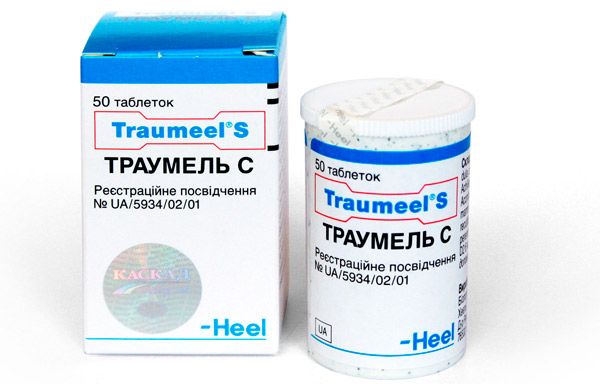
The standard dosage for the treatment of osteochondrosis is one tablet three times in 24 hours. Take the drug before eating (not earlier than 15 minutes). The tablet should not be swallowed or chewed, just keep in your mouth until it completely resolves.
Patients with leukemia, tuberculosis, intolerance to lactose and components of the drug, multiple sclerosis, AIDS to take the drug is prohibited. Can not be used to treat children under twelve. For the therapy of pregnant women, it is important to first consult a doctor.
In rare cases, the drug can cause allergic reactions, increased salivation.
Vitamins from osteochondrosis
Vitamins are divided into two large groups:
- Fat-soluble (vitamins K, D, E, A).
- Those that dissolve in water (vitamins B and C).
Patients with osteochondrosis are usually prescribed whole vitamin complexes to improve the patient's condition and make the therapy more effective. But at the same time, it is best to pay attention to the vitamins that are included in group B (B12, B1, B6). With their help, you can reduce the strength of pain that appears in the back area, as well as to reduce neurological disorders and trophic tissue disorders.
In addition to vitamins, in the treatment of osteochondrosis, it is also necessary to take various micro- and macro elements: zinc, potassium, phosphorus, magnesium. Thanks to them, the bone tissue is strengthened, the blood supply to the musculoskeletal system and the muscular skeleton of the spine are improved. As a rule, most of the mineral components are included in the vitamin complexes. Remember that they are selected by the attending physician, based on the individual characteristics of the human body. The most popular complexes of vitamins are:
- Duovit.
- Complivit.
- Vitrum.
- Oligovit.
- Pentovit.
- Centrum.
- Decemevit.
- Unicab.
- Calcium D3-Nycomet.
- Supradin.
On average, vitamin therapy lasts about one month, although the doctor can also extend this course if necessary. You can repeat it in three months.
A nicotinic acid
Nicotinic acid is referred to a group of drugs that are vitamin derivatives. Thanks to this medicine, the patient can:
- Normalize metabolic processes, strengthen the nervous system.
- Improve lipid and carbohydrate metabolism.
- Normalize the blood supply in the brain.
- Expand blood vessels, normalize vascular tone.
- Cleanse the body of poisoning.
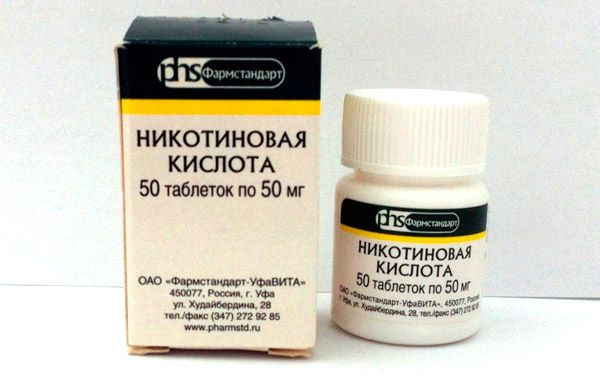
Nicotinic acid has a fairly wide application in medicine, but most often it is prescribed specifically for the treatment of osteochondrosis of the spine. Nicotinic acid is sold in a variety of forms, but the most popular are exactly tablets.
It is recommended to drink nicotinic acid in case of osteochondrosis and prevent this disease at least twice a year (in spring and autumn). The dosage of the drug can be different (it depends on the severity of the disease and the patient's condition), but usually patients drink one to two tablets three times per 24 hours. If you have an increased acidity of the stomach, tablets should be taken after meals. Drink recommended with water or milk.
 [16],
[16],
Tablets from dizziness with osteochondrosis
Most often, dizziness in osteochondrosis occurs after sleep. Especially if the patient sleeps on a pillow that is too high, tilts or turns his head sharply. Dizziness is often provoked if the patient turns his head in different directions. It can last several minutes or even hours. This is because in patients with osteochondrosis, the arteries are compressed by vertebrae.
There are many methods for treating dizziness in osteochondrosis, they are all complex. Most often, doctors prescribe a variety of chondroprotectors that help restore cartilage. Often the complex includes vasodilators that help to relieve dizziness and headaches, which often accompany them.
Also, often specialists prescribe drugs that help improve the vestibular apparatus and blood microcirculation, anti-inflammatory drugs to relieve the inflammatory and edematous process between the vertebral discs.
Trental
Angioprotector, which helps improve blood microcirculation and increases the elasticity of red blood cells. It is often used for dizziness in patients with osteochondrosis.
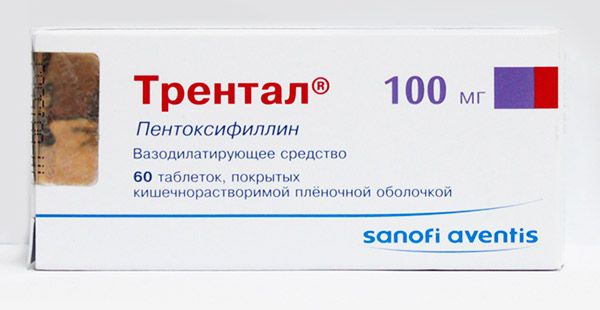
Dosage, as well as the duration of therapy, is established by the attending physician. Patients with acute myocardial infarction, hemorrhagic stroke, massive bleeding, hemorrhages in the retina, arrhythmia, atherosclerosis and intolerance of the drug components are prohibited. Breastfeeding for the period of treatment should be discontinued.
In some cases, the drug can cause flushing of the skin on the face, drowsiness or loss of sleep, brittle nails, decreased appetite, cholestatic hepatitis, cattle, tachycardia, hypophybinogenemia, allergies.
Actovegin
A remedy that helps to activate metabolism in tissues, improve trophic, stimulate the regeneration process. The drug contains the active ingredient deproteinized hemoderivat from calf blood. Due to this the preparation helps to strengthen oxidation processes, improves oxygen consumption.
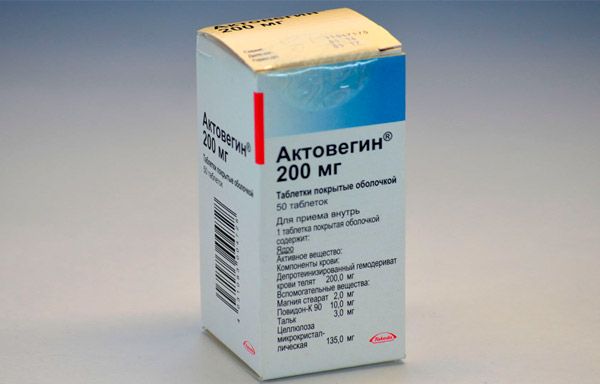
The standard dosage is one to two tablets three times per 24 hours. Drink a remedy before eating. Drink plenty of fluids. The course lasts from four to six weeks.
Patients with heart failure, anuria, oliguria, pulmonary edema and hyperhydration should be taken with caution. It is forbidden to use with intolerance of the drug component. For treatment of pregnant women should consult a specialist.
In rare cases, taking the drug can lead to fever, edema, hives.

Tablets with headache with osteochondrosis
Headache with osteochondrosis manifests itself very often and can have a different intensity: from insignificant to unbearable. It appears because of the squeezing of the arteries that pass along the spine, bone outgrowths. The pain is bursting, it can become stronger if the patient moves his head or makes eyeball movements. The patient may experience nausea, as well as vomiting, weakness in the whole body.
Analgesics can not cope with a headache with osteochondrosis. Therefore, doctors recommend eating tablets that affect the symptoms of osteochondrosis. Because of severe attacks, headaches in patients with osteochondrosis were called "cervical migraine." A very good remedy for headache with osteochondrosis are various warming ointments.
Anti-inflammatory pills for osteochondrosis
Anti-inflammatory tablets play a very important role in the treatment of osteochondrosis, since this disease is accompanied by the destruction of bone tissue and intervertebral ligaments and joints, which is accompanied by a strong inflammatory process and edema of tissues.
Nonsteroidal anti-inflammatory drugs, acting on different substances, suppress pain sensitivity. This group of drugs not only anesthetizes, but also reduces fever, removes inflammation and swelling.
Among the most popular anti-inflammatory tablets from osteochondrosis is:
- Diclofenac.
- Voltaren.
- Aspirin.
- Butadione.
- Indomethacin.
- Nimesulide.
- Ketoprofen.
 [17],
[17],
Diclofenac
A popular non-steroidal anti-inflammatory drug in which the active ingredient diclofenac sodium is found. It differs not only in anti-inflammatory effect, but also relieves pain and fever.
The dosage is prescribed by the attending physician, but adult patients, as a rule, take 25-50 mg two to three times in 24 hours. Tablets can not be chewed and taken while eating. Once the therapeutic effect is achieved, the dose should be gradually reduced. The maintenance dosage is 50 mg in 24 hours.
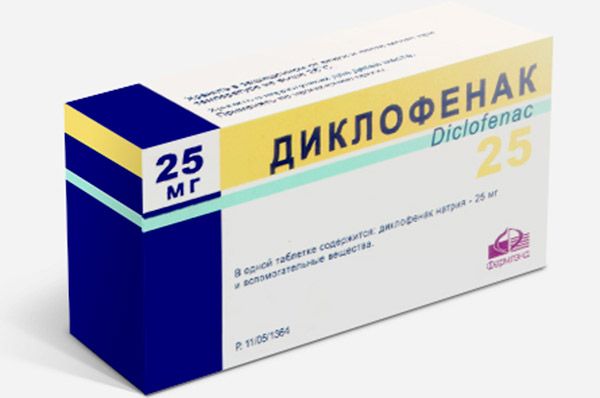
Patients with a high risk of developing gastric bleeding, erosions and ulcers, aspirin asthma, hemopoiesis, hemophilia, intolerance to diclofenac should not drink the drug. For the treatment of pregnant women, children (up to six years), women who are breastfeeding the baby are not used. If the patient has anemia, congestive heart failure, bronchial asthma, take the drug with extreme caution.
In some cases, the reception can cause abdominal pain, diarrhea, constipation, jaundice, vomiting, liver necrosis, hepatitis, colitis, decreased appetite, cirrhosis, headaches, drowsiness, irritation, a sense of fear, tinnitus, diplopia, cattle.
Voltaren
Non-steroidal anti-inflammatory drug based on diclofenac sodium. It differs in anti-inflammatory, antipyretic and analgesic effect.
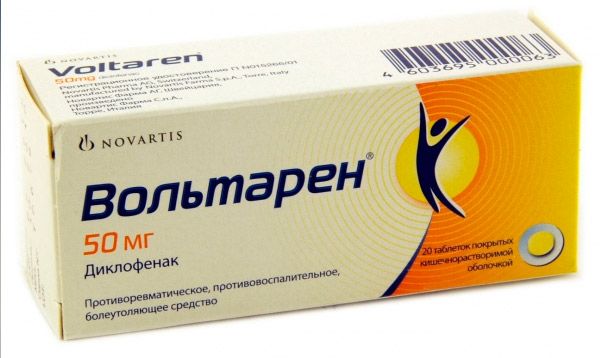
Dosage is individual, but doctors recommend taking a minimally effective dose. The standard dose is 100-150 mg in 24 hours. Tablets should be swallowed and washed down with plenty of liquid. Patients with a stomach ulcer, inflammatory bowel disease, bronchial asthma, renal or hepatic insufficiency, aortocoronary shunting, intolerance to diclofenac should not be taken. It is not prescribed for the treatment of pregnant women.
In some cases, the reception may be accompanied by nausea, abdominal pain, colitis, gastritis, vertigo, diplopia, headaches, seizures, allergies.
Aspirin
A popular remedy that is taken with osteochondrosis to relieve inflammation. The medicine contains acetylsalicylic acid. It differs with antipyretic, analgesic effect. Inhibits cyclooxygenase enzymes, which take part in the synthesis of protaglandins.

You can take the drug from the age of fifteen. The standard dosage is 0.5-1 g at a time. Between the admission it is necessary to make intervals of four hours. In a day you can not drink more than six tablets. It is necessary to take the tablets with plenty of liquid during the intake. Take the drug is not recommended for more than seven days.
Patients with a stomach ulcer, hemorrhagic diathesis, bronchial asthma, intolerance to the components of the drug to take it is prohibited. Do not take with methotrexate. It is not recommended to appoint pregnant women (especially in the first and third trimesters of pregnancy).
In some cases, after taking the drug, nausea, diarrhea, headaches, increased pressure, dizziness, and allergy may occur.
Butadione
A popular anti-inflammatory drug based on phenylbutazone. Helps to remove swelling, inflammation, reduce heat and pain. It also comes in the form of an ointment.
Take recommended for 0.2-0.4 g three to four times in 24 hours during meals. It can be taken for the treatment of small children, but only after the appointment of the attending physician. The course of treatment lasts from two to five weeks, but can be extended if necessary.

Patients with gastric ulcer, bone marrow depression, pulmonary or heart failure, hypertension, hemophilia, hypocoagulation, stomatitis, diabetes mellitus, intolerance to aspirin drugs and drug components can not be taken. It is not recommended to use for treatment of pregnant women and during lactation.
May cause dyspepsia, gastropathy, nausea, diarrhea, heartburn, glossitis, headaches, tachycardia, leukopenia, abdominal cramps, uterine bleeding.
 [27]
[27]
Indomethacin
Anti-inflammatory drug based on the derivative of indoleacetic acid. Reduces the aggregation of platelets. It differs in analgesic, anti-inflammatory, antipyretic effect.
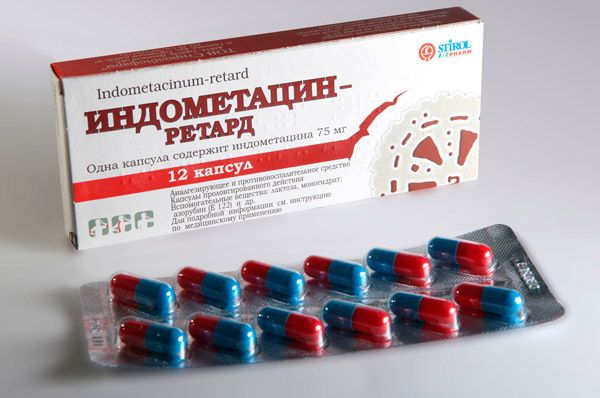
Dosage is assigned individually depending on the severity of the disease and the patient's condition. The standard dose for treating adults is 25 mg two to three times in 24 hours. If the clinical effect is not achieved, you can increase the dose to 50 mg.
Patients with stomach ulcers, impaired renal and hepatic function, heart failure, pancreatitis, intolerance to drug components are prohibited from using it. It is not prescribed for treatment of children under fourteen years of age and pregnant women.
In some cases, the medication can cause anorexia, abdominal pain, stomatitis, headaches, dizziness, convulsions, tachycardia, allergies, leukopenia, diplopia, hyperglycaemia.
Nimesulide
An anti-inflammatory drug that is a selective COX-2 inhibitor based on nimesulide. It differs by antipyretic, antiplatelet and antipyretic effect.
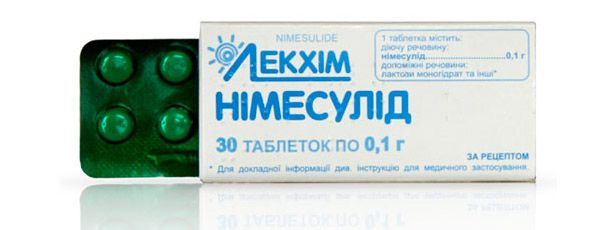
Dosage is individual and is prescribed by the attending physician. The standard dose is 100 mg of the drug twice every 24 hours. Drink after meals. Patients with bronchial asthma, stomach ulcers, bleeding in the stomach, Crohn's disease, hemophilia, heart failure, kidney failure, hyperglycemia, intolerance to nimesulide to take the drug is prohibited. It is not prescribed for the treatment of osteochondrosis in pregnant women, women who feed the baby with breast milk, addicts and people suffering from alcoholism.
During the reception of this drug, the following unpleasant symptoms and diseases may manifest: anaphylactic reaction, nervousness, headaches, Reye syndrome, allergy, dysuria, oliguria, diarrhea, hepatitis, constipation, nausea, dyspnea, hypertension.
Ketoprofen
Anti-inflammatory drug based on a derivative of propionic acid. It has a pronounced analgesic effect, has antipyretic and anti-inflammatory effect.
Dosage is established for each patient individually, since it depends on the severity of his condition. The standard daily dose is 300 mg, which must be drunk two to three times.
Patients with a stomach ulcer, kidney and liver diseases, aspirin triad, intolerance to salicylates and ketoprofen can not be used. It is not recommended to take pregnant women, children under fifteen.
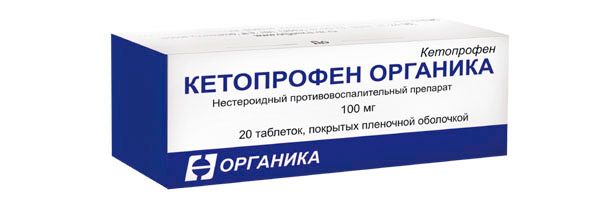
In some patients, this medication caused nausea, anorexia, vomiting, diarrhea, headaches, tinnitus, bronchospasm, and impaired renal function.
Tablets from pain with osteochondrosis
To improve the patient's condition, which is ill with osteochondrosis, is very difficult by any one method. But pharmacological agents play the most important role in any therapy.
Thanks to drug therapy, you can cope with almost all the problems that occur with osteochondrosis:
- Eliminate severe pain.
- Relax the muscles.
- Remove the inflammation.
- Restore the cartilage.
- Improve blood circulation.
Among the tablets that are taken with osteochondrosis, an important place is occupied by painkillers. In cases where the pain is not very strong, even an analgin can remove it, but usually doctors prescribe stronger drugs to patients: Dexalgin, Ketorolac, Renalgan, Naiz, Ketanov.
But it is worthwhile to understand that the anesthetics do not affect the pathological process. They can only relieve tension in the muscles, improve activity, normalize sleep and the emotional state of the patient. To eliminate not only pain, but also inflammation, it is necessary to take non-steroidal anti-inflammatory drugs.
Nyz
Anti-inflammatory drug based on nimesulide. Removes edema, pain, fever.

The standard dosage is 100 mg twice every 24 hours. Do not exceed the maximum dose set to 400 mg. Pills to drink after eating. Patients with a stomach ulcer, aspirin triad, liver disease, renal insufficiency, dermatosis, intolerance to the components of the drug to take it is prohibited. It is not recommended for pregnant women and those who are breastfeeding.
In some cases, taking Naise can lead to nausea, vomiting, diarrhea, dizziness, headaches, allergies, hematuria, thrombocytopenia.
Analgin
A popular analgesic in which the active ingredient is - a derivative of pyrazolone. It differs in anti-inflammatory, antipyretic, analgesic effect.
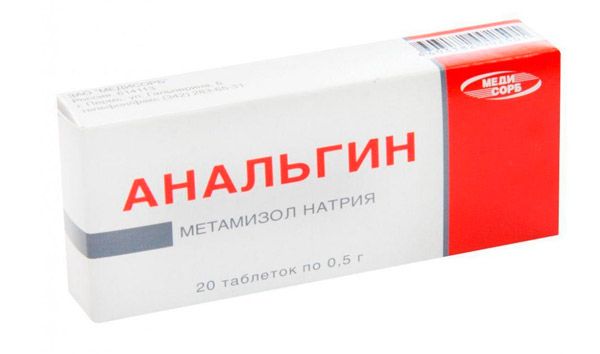
250-500 mg is taken two to three times in 24 hours. Do not exceed the maximum prescribed dose - 1 g. For children, the appointment of a doctor is necessary, since the dosage is determined individually.
Patients with problems in the liver and kidneys, glucose deficiency, blood diseases, intolerance to the main components of the drug to use it is prohibited. May cause allergic reactions, leukopenia, agranulocytosis.
 [28],
[28],
Ketanov
Non-steroidal anti-inflammatory drug derived from pyrrolizine-carboxylic acid. It has a pronounced analgesic effect. Also removes inflammation, fever and swelling.
The standard dosage is 10 mg every four to six hours. If necessary, it can be increased to 20 mg three to four times in 24 hours. Patients with stomach ulcers, craniocerebral hemorrhages, kidney diseases, bronchial asthma, polyps, angioedema, intolerance to the components of the drug can not take it. It is not recommended to use for treatment of pregnant women, patients during lactation, children under sixteen.
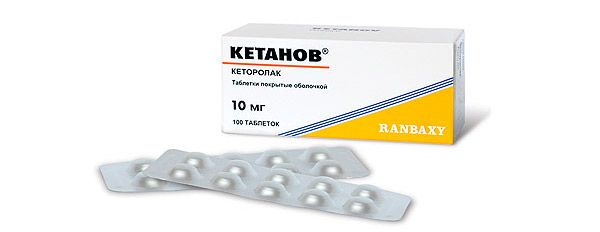
In some cases, taking Ketanov can lead to unpleasant symptoms and diseases: anxiety, paresthesia, euphoria, dizziness, nausea, bradycardia, fainting, attacks of suffocation, anemia, oliguria, hematuria, allergy, fever.
Tablets, relaxing muscles with osteochondrosis
One of the symptoms of osteochondrosis is the appearance of tension in the muscles throughout the body. That is why muscle relaxants are very popular drugs in the complex therapy of this disease.
All of them can be divided into two large groups:
- Means that act peripherally.
- Means that affect centrally - have an effect on the central nervous system.
It is worthwhile to understand that these drugs themselves have no therapeutic effect, but due to the fact that muscles relax, the patient can improve his condition. In no case can they be used alone. Remember that muscle relaxants are prescribed only by a specialist.
Among the most popular drugs in this group are:
- Baclofen.
- Cyclobenzaprin.
- Midsummer.
Baclofen
A popular central muscle relaxant based on baclofen. Helps to eliminate muscle spasm. Also has a small analgesic effect.
The standard dosage is 5 mg three times in 24 hours. Drinking tablets is recommended only during meals, squeezed with enough liquid. Every third day, the dosage is increased by 5 mg until the patient has a positive clinical effect. Do not exceed the maximum allowable dose - 100 mg.
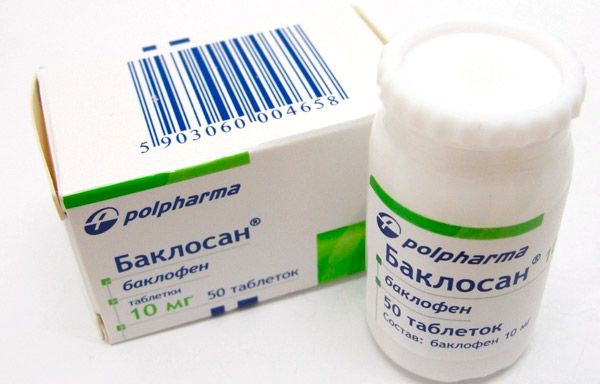
Patients with intolerance to the main component of the drug, epilepsy to take the drug is prohibited. Do not use to treat women who are breastfeeding, and pregnant women. Side effects occur in all patients, so these pills can be taken only under the strict supervision of the attending physician and on his recommendation.
 [29]
[29]
Cyclobenzaprine
A popular muscle relaxant of central action, in which the active component of cyclobenzaprine is located. It has an easy analgesic effect.
The standard dosage for the treatment of adult patients is 20-40 mg two to four times in 24 hours. Do not exceed the maximum allowable dose - 60 mg.
Patients with intolerance to the components of the drug to take it is prohibited. It is not used to treat pregnant women and during lactation. Side effects from taking this drug are very often: allergies, hyperemia, rash, urination disorders.
 [30],
[30],
Midokalm
Miorelaxant based on tolperisone hydrochloride, which has an effect on the central nervous system. It differs locally anesthetic, membrane-stabilizing action.
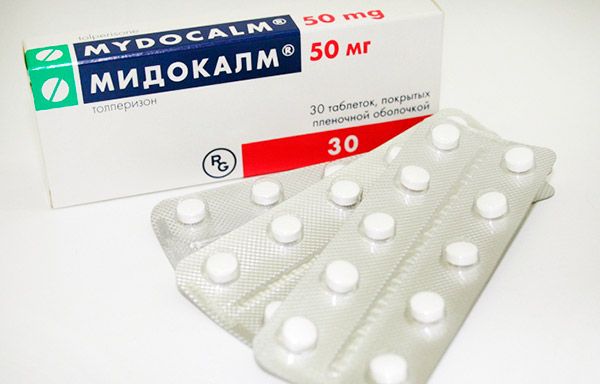
The standard dosage for the treatment of adult patients (from the age of fourteen) is 50 mg two to three times in 24 hours. The dose gradually rises to 150 mg two to three times in 24 hours. For treatment of children the dosage is established by the attending physician. Tablets are taken orally by squeezing a lot of liquid.
Patients with myasthenia gravis, intolerance to the components of the drug to take it is prohibited. It is not recommended to use for treatment at an early age (up to three years), pregnant women, during lactation. May cause arterial hypotension, muscle weakness, headaches, allergies, nausea, bronchospasm.
Use of the tablets from osteochondrosis during pregnancy
Osteochondrosis is one of those serious diseases that must necessarily be cured before the onset of pregnancy. But even in perfectly healthy women during pregnancy, there may be osteochondrosis of the cervical spine. Tablets that successfully treat any kind of osteochondrosis are completely contraindicated for the therapy of pregnant women. This can be explained by the fact that they negatively affect the development of the fetus and the condition of the patient herself.
That is why, if a woman has symptoms of osteochondrosis during pregnancy, various non-medicament means are prescribed.
Attention!
To simplify the perception of information, this instruction for use of the drug "Tablets from osteochondrosis" translated and presented in a special form on the basis of the official instructions for medical use of the drug. Before use read the annotation that came directly to medicines.
Description provided for informational purposes and is not a guide to self-healing. The need for this drug, the purpose of the treatment regimen, methods and dose of the drug is determined solely by the attending physician. Self-medication is dangerous for your health.

